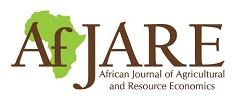Agricultural digitisation and agricultural development: A comparison between developed and developing countries
Ettayib Mezouri & Mourad Beniani
Abstract
Agricultural digitisation is one of the key drivers of agricultural development, as well as of rapid economic growth, in many countries. This study aims to investigate the causal links between agricultural digitisation and high-quality agricultural development in the context of developed and developing countries. To this end, we apply a cross-sectional autoregressive distributed lag (CS-ARDL) approach and method of moments quantile regression (MMQR) to explore the association between these variables in four quantiles (Q0.25, Q0.50, Q0.75, Q0.90) to analyse panel data from the period 2010 to 2024.The empirical results of the CS-ARDL-MMQR technique show that agricultural digitisation has a significant and positive impact on the development of high-quality agriculture at a 1% statistical level in both panels in the long run. The impact of agricultural digitisation and agriculture value added is more evident in developed countries. In the context of developing countries, agricultural digitisation is found to be too insignificant to have an effect on the development of high-quality agriculture. Besides, a heterogeneity analysis showed that agricultural digitisation played a more significant role in developed countries than in developing countries. The results of the Dumitrescu-Herlin (DH) causality test show that the majority of the variables had one-way causality towards the development of high-quality agriculture in both panels, except for the agricultural digitisation and development of high-quality agriculture, which had two-way causality in developed countries only. The empirical findings suggest that, through improved agricultural digitisation in developed countries, more funds could be invested in agricultural digitisation projects to adopt the development of high-quality agriculture in developing countries.
